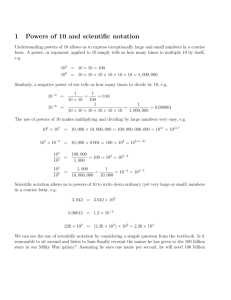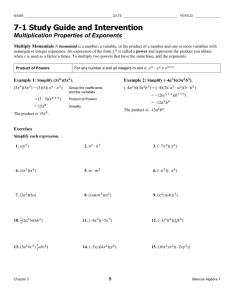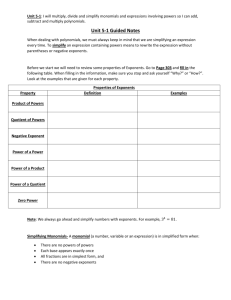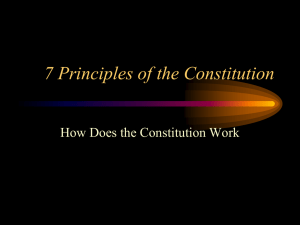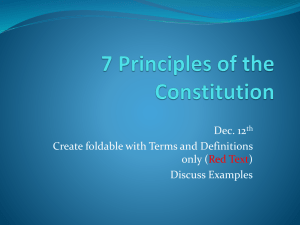Indices (Powers) & Roots
advertisement
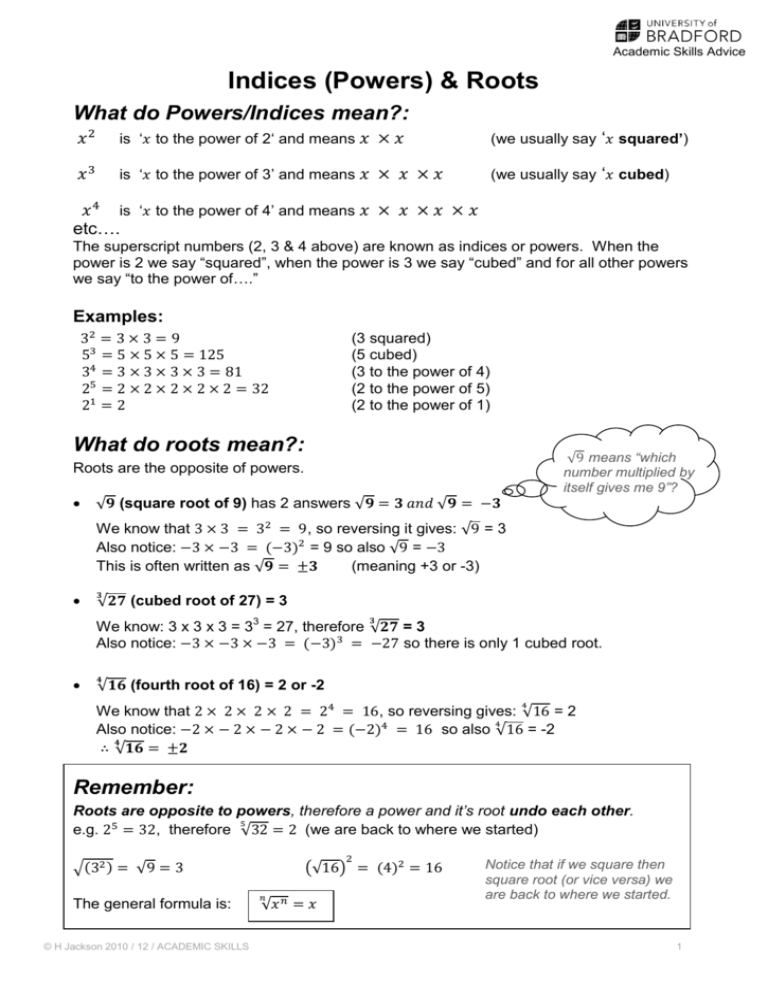
Academic Skills Advice Indices (Powers) & Roots What do Powers/Indices mean?: 𝑥2 is ‘𝑥 to the power of 2‘ and means 𝑥 × 𝑥 (we usually say ‘𝑥 squared’) 𝑥3 is ‘𝑥 to the power of 3’ and means 𝑥 × 𝑥 × 𝑥 (we usually say ‘𝑥 cubed) 𝑥 4 is ‘𝑥 to the power of 4’ and means 𝑥 × 𝑥 × 𝑥 × 𝑥 etc…. The superscript numbers (2, 3 & 4 above) are known as indices or powers. When the power is 2 we say “squared”, when the power is 3 we say “cubed” and for all other powers we say “to the power of….” Examples: 32 = 3 × 3 = 9 53 = 5 × 5 × 5 = 125 34 = 3 × 3 × 3 × 3 = 81 25 = 2 × 2 × 2 × 2 × 2 = 32 21 = 2 (3 squared) (5 cubed) (3 to the power of 4) (2 to the power of 5) (2 to the power of 1) What do roots mean?: √9 means “which number multiplied by itself gives me 9”? Roots are the opposite of powers. √𝟗 (square root of 9) has 2 answers √𝟗 = 𝟑 𝑎𝑛𝑑 √𝟗 = −𝟑 We know that 3 × 3 = 32 = 9, so reversing it gives: √9 = 3 Also notice: −3 × −3 = (−3)2 = 9 so also √9 = −3 This is often written as √𝟗 = ±𝟑 (meaning +3 or -3) 𝟑 √𝟐𝟕 (cubed root of 27) = 3 𝟑 We know: 3 x 3 x 3 = 33 = 27, therefore √𝟐𝟕 = 3 Also notice: −3 × −3 × −3 = (−3)3 = −27 so there is only 1 cubed root. 𝟒 √𝟏𝟔 (fourth root of 16) = 2 or -2 4 We know that 2 × 2 × 2 × 2 = 24 = 16, so reversing gives: √16 = 2 4 Also notice: −2 × − 2 × − 2 × − 2 = (−2)4 = 16 so also √16 = -2 𝟒 ∴ √𝟏𝟔 = ±𝟐 Remember: Roots are opposite to powers, therefore a power and it’s root undo each other. 5 e.g. 25 = 32, therefore √32 = 2 (we are back to where we started) 2 (√16) = (4)2 = 16 √(32 ) = √9 = 3 The general formula is: © H Jackson 2010 / 12 / ACADEMIC SKILLS 𝑛 √𝑥 𝑛 = 𝑥 Notice that if we square then square root (or vice versa) we are back to where we started. 1 Roots and powers of numbers can be worked out using a calculator, but we need some rules to help us when we have algebra involved. The Rules of Indices: The following are the rules that you need to learn and practice: Rule 𝒂𝒑 × 𝒂𝒒 = 𝒂𝒑+𝒒 𝒂𝒑 𝒂𝒒 = 𝒂𝒑−𝒒 (𝒂𝒑 )𝒒 = 𝒂𝒑×𝒒 𝒂−𝒑 = 𝒒 𝒑 𝟏 𝒂 = ( √𝒂) Example If you multiply 2 numbers with the same base you add the powers. 35 × 37 = 312 If you divide 2 numbers with the same base you subtract the powers. 79 = 74 75 If you have a power inside and a power outside of a bracket you multiply the powers. (45 )2 = 410 A negative power means “one over” so everything is sent to the bottom of a fraction. 𝒂𝒑 𝒑 What does it mean? 𝒒 𝒂𝟎 = 𝟏 𝒂𝟏 = 𝒂 𝟏𝒂 = 𝟏 9−4 = 1 94 A fractional power means a root. The bottom of the fraction tells you which root to take and the top tells you which power. 164 = ( √16) = 23 Anything to the power of zero = 1 3720 = 1 Any number to the power of 1 stays the same. 541 = 54 1 to the power of anything = 1 18 = 1 3 4 3 This may seem like a lot to learn but as you practice them they will become easier to remember. (See the following pages for some examples.) © H Jackson 2010 / 12 / ACADEMIC SKILLS 2 Examples: Simplify 𝒙𝟑 × 𝒙𝟐 × 𝒙𝟒 Why do we add the power? Notice that the X sign is a continuation of what the powers mean: 𝒙𝟑 × 𝒙𝟐 × 𝒙𝟒 means 𝒙 × 𝒙 × 𝒙 × 𝒙 × 𝒙 × 𝒙 × 𝒙 × 𝒙 × 𝒙 = 𝒙𝟗 The bases (𝑥) are all the same and so we just add the powers: 𝑥 3 × 𝑥 2 × 𝑥 4 = 𝑥 3+2+4 = 𝒙𝟗 Simplify 𝒙𝟓 × 𝒚𝟐 × 𝒙𝟑 Be careful not to combine different bases. We can only add the powers with a base of 𝑥. The base of 𝑦 is different so it stays separate. 𝑥 5 × 𝑦 2 × 𝑥 3 = 𝑥 5+3 × 𝑦 2 = 𝑥8𝑦2 Simplify 𝟑𝒙𝟐 × 𝟒𝒙𝟑 We have numbers as well so just multiply the numbers and add the powers. 3𝑥 2 × 4𝑥 3 = 3 × 4 × 𝑥 2+3 = 12𝑥 5 Why do we subtract the power? The division could be written as: 25×𝑦×𝑦×𝑦×𝑦×𝑦×𝑦×𝑦 5×𝑦×𝑦×𝑦×𝑦 Notice that the 4 𝑦’s on the bottom will cancel with 4 from the top leaving 3 𝑦’s on the top. Simplify 𝟐𝟓𝒚𝟕 ÷ 𝟓𝒚𝟒 Divide the numbers and subtract the powers. 25𝑦 7 ÷ 5𝑦 4 = (25 ÷ 5) (𝑦 7−4 ) = 5𝑦 3 Simplify 𝒙𝟓 ÷ 𝒙−𝟐 Subtract the powers but be careful with the signs. 𝑥 5 ÷ 𝑥 −2 = 𝑥 5−(−2) = 𝑥 5+2 = 𝑥7 Simplify (𝟐𝒙𝟑 )𝟐 Multiply the powers (and remember that 2 is also to the power of 2). (2𝑥 3 )2 = 22 (𝑥 3 )2 © H Jackson 2010 / 12 / ACADEMIC SKILLS = 4𝑥 6 3 Simplify 𝒙−𝟓 Remember the rule that the (–) sign in front of a power sends everything to the bottom. 𝟏 𝑥 −5 = 𝒙𝟓 Simplify 𝟑𝒙−𝟓 This is the same as: 3 × 𝑥 −5 . 1 3 × 𝑥 −5 = 3 × 𝑥 5 𝟑 = 𝒙𝟓 𝟏 Simplify 𝒙−𝟐 Now the (–) sign in front of the power is already on the bottom of the fraction so this time it sends everything to the top. 1 = 𝒙𝟐 𝑥 −2 Write √𝒚 as a power Remember that roots are fractional powers. This is the square root and so the denominator of the fraction will be 2. 𝟏 √𝑦 = 𝒚𝟐 𝟒 Write √𝒙 as a power This is the fourth root and so the denominator of the fraction will be 4. 𝟏 4 √𝑥 = 𝒙𝟒 Write ( 𝟑√𝒚) 𝟐 as a power This is the third root and so the denominator of the fraction will be 4. It is then squared and so the numerator will be 2 ( 3√𝑦) 2 𝟐 = 𝒚𝟑 Simplify √𝒚 × 𝒚𝟑 × √𝒚 1 1 = 𝑦2 × 𝑦3 × 𝑦2 1 1 = 𝑦 2+3+2 © H Jackson 2010 / 12 / ACADEMIC SKILLS = 𝑦4 4

